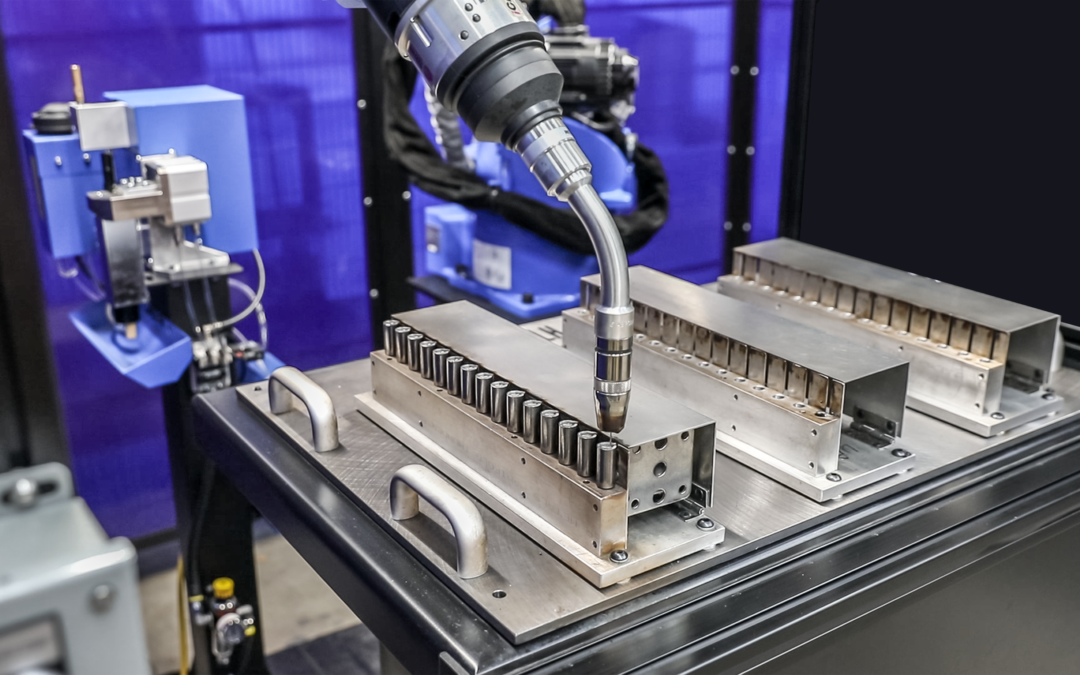
Robotic Welding Explainer Video
This narrated explainer video goes deep into the features and benefits associated with the newest robotic welding tech.

This narrated explainer video goes deep into the features and benefits associated with the newest robotic welding tech.
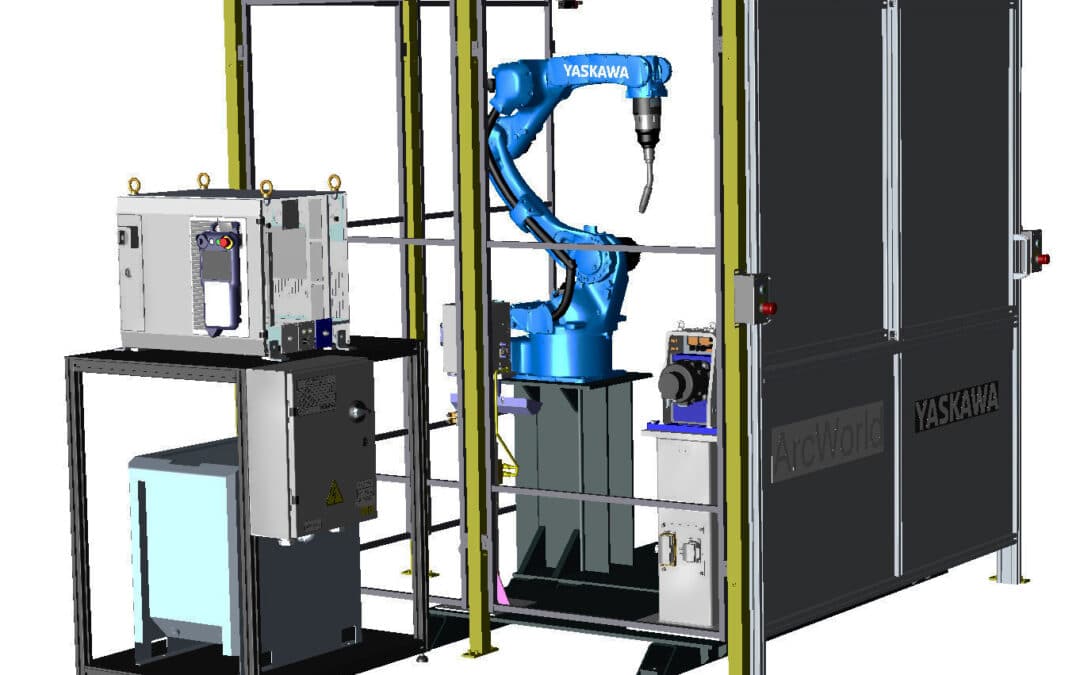
From prototyping to short-run to high-volume, super-efficient lines, robots can handle an extremely broad spectrum of production assignments. Ajax recently installed a Yaskawa AR1440 robot with a welding effector.
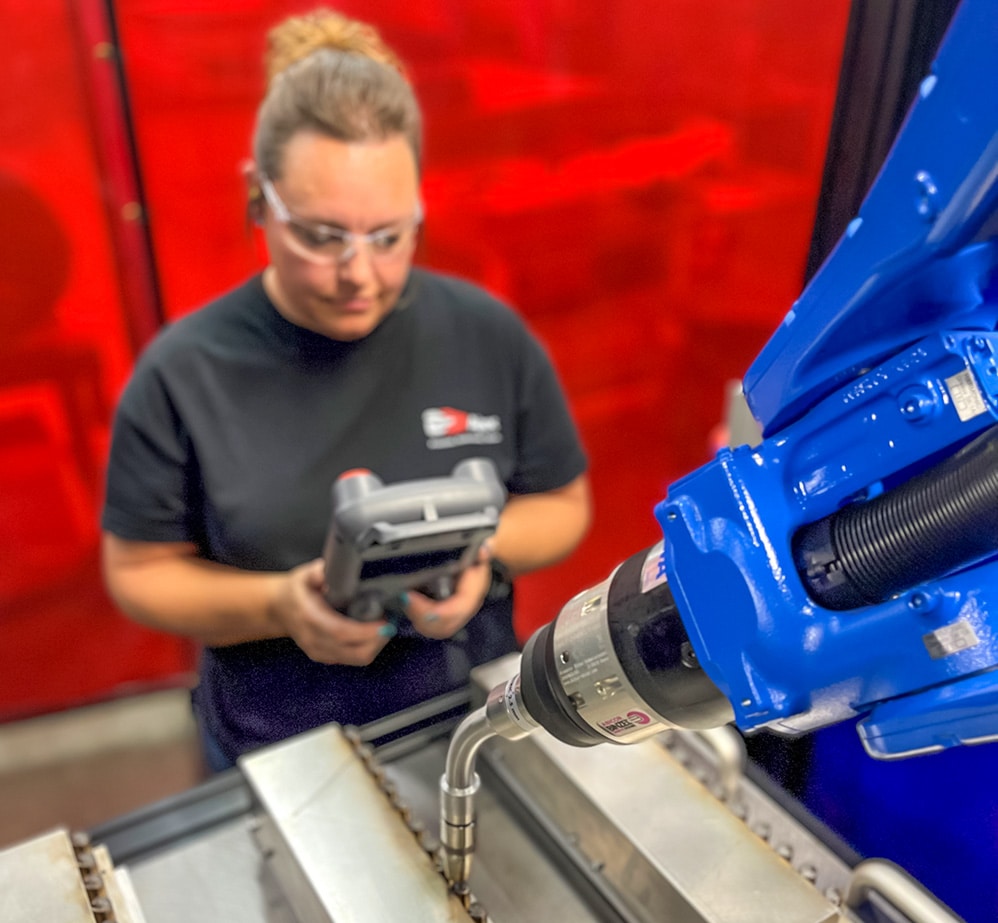
This new welding cell enables Ajax to produce high-quality welds efficiently and consistently and will eliminate many of the bottlenecks associated with manual welding operations. Read more on our Welding page.
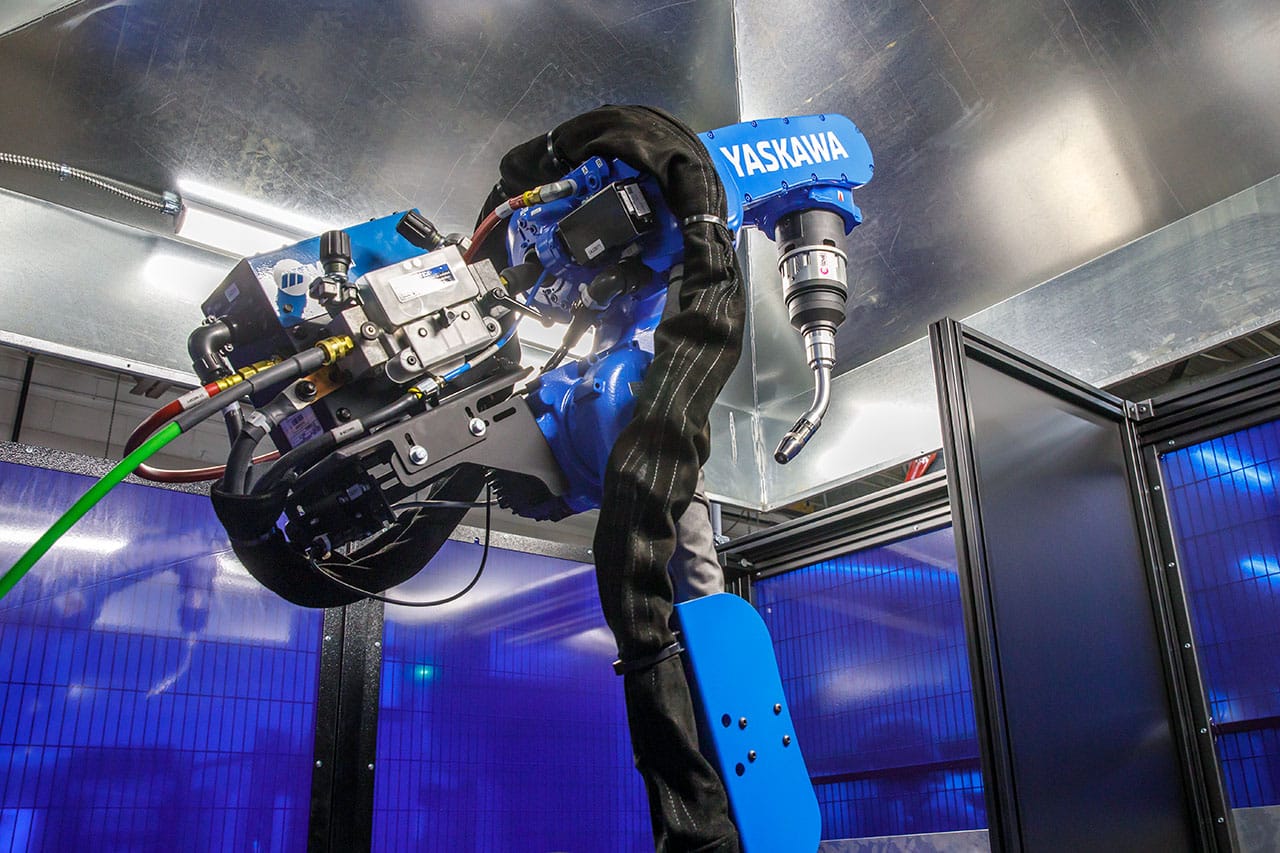
The Ajax welding cell is a fully enclosed, dual workstation cell with safety interlocking sliding doors. It features a Miller Auto-Continuum MIG power supply for superior weld control, a smart touchscreen teaching pendant, and faster and more efficient offline programming.
From the metal former’s perspective, the benefits of industrial robots are significant and multi-faceted. Primary among them are safety, quality, speed, versatility, and resource allocation. Here’s more detail on each of these benefits:
1. Operator Safety
These days, operator safety is the nut hand*. Many Ajax colleagues have been working together for years and are good friends. No one wants to see a friend get hurt. Robotics can reduce the risk of repetitive motion injury, burn, toxic inhalation, eye damage, and cutting or crushing injury (two thumbs up!). There’s also practical aspects: accidents and injuries can shut down production lines, resulting in late shipments to customers and increased insurance premiums. Anything Ajax can do to reduce that risk is generally worth the expense and effort.
*In poker, the “nut hand” is the strongest possible hand in a given situation and a guaranteed winner. As the story goes, in the old days, a player with such a hand might bet beyond his stake and place the nuts from his wagon wheel on the table, thus assuring other players that he would be unable to flee and would have to make good on his wager.
2. Consistent Quality
Because robotic movements are so precise – generally within 0.02 mm of repeatable accuracy – quality issues are very rare. In fact, it’s far more likely that any non-conformance is related to flaws in materials, fixtures, machine setup, or electrical power interruptions rather than the robotic machinery. Robots make few mistakes, so there’s very little material waste, adding to overall efficiency.
In both production and material handling applications, industrial robots utilize end-of-arm tools (EOATs), also known as end effectors, to hold, manipulate, and perform the work. Robotic effectors, often provided separately by third-party companies, include grippers, magnets, sensors, clamps, suction cups, cameras, welding torches, sanders, and more. The third-party companies that make effectors have come a long way in the past few years and can design their products to take full advantage of the vast range of robotic capabilities.
3. Production Speed
Industrial robots are fast. The volume of parts a robot can crank out in an hour relative to manual production is truly impressive. Even moderately-sized Robotic Weld robots offer thousands of pounds of payload capacity and a reach of 10-20 feet or more. With this kind of range, process improvement engineers can consistently amazing welds. The precise configure robotic solutions that get the job done quickly.
In addition, the fatigue that humans can experience over an eight or ten-hour shift often leads to speed reduction and mistakes. Robots can go at it 24-7 with no performance degradation.
4. Versatility
Industrial robot operating systems are much improved these days, enabling operators to program a wide variety of metal forming tasks. The custom fixtures that hold the workpieces are created in-house, adding to versatility.
Motion controllers, the brains of robots, can be scaled or adapted to meet customer needs relatively quickly. Up to four robots can be added to a single controller to multiply part production. Plus, robots can be programmed to perform multiple jobs in a single setup, reducing project transition times.
5. Operator Assignment
When it’s hard to find good colleagues (like now), robots help shorthanded shifts keep up the pace. A job that might have taken three welders can now be performed by a single robot operator, freeing two workers for other fabrication projects. That’s a huge advantage, especially now.
Conclusion
The manufacturing skills gap persists, despite our best efforts to attract, educate, and grow our manufacturing workforce, making the arrival of industrial robots on the plant floor a welcome sight indeed. Robots bring safety, quality, speed, versatility and other production benefits that are too important to ignore. And for the metal forming customer: consistent conformance, on-time deliveries, and the lowest possible cost.
Yet automation success still hinges on humans. Critical thinking, problem-solving, process engineering, and fine-tuned people skills are needed to amplify the benefits of robots. It’s ironic that industrial automation, often labeled a job-killer in decades past, will instead enhance and extend career opportunities for colleagues willing to learn a new skill set.
Automated production solutions such as industrial robots are a hit because they’re win-win. Both Ajax and our customers will realize the benefits. By investing in industrial robots, and the people we need to engineer and operate them, Ajax is taking yet another big step toward ongoing continuous improvement and maximized customer satisfaction.
Many thanks to our friends at Mechatronic Solutions for their assistance with this robotics project.

Ajax Metal Forming Solutions and Sales Engineer Jayson Marcott have again joined the robotics team at Providence Academy of Plymouth, Minnesota, to create a new entry for the FIRST® Robotics Competition. FIRST® is the world’s leading youth-serving nonprofit advancing science, technology, engineering, and math (STEM) education.
FIRST® organizes teams of high school students and their instructors to build high-tech robots that launch balls into goals, hang on bars, operate along balance beams, and more. Although a kit of standard robot parts is provided, FIRST® encourages teams to design custom parts that improve robot performance. That’s where Ajax and Sales Engineer Jayson Marcott stepped in to assist. The Providence team designed custom parts made from lightweight aluminum but lacked the material and machinery needed to make the parts. Ajax provided the aluminum and allocated time on the company’s Salvagnini L3 fiber laser and Loewer Beltmaster to cut and deburr the parts.
“Providence Academy has a very impressive group of youngsters on their robotics team,” Jayson said. “We’re very excited to see how this year’s robot performs in competition.” Last year, Providence finished 7th out of 25 teams but won the FIRST® Engineering Award.
“Our team got right to work to replace the robot’s wooden prototypes with the finished laser-cut plates that Ajax produced,” said Providence Physics and Engineering Instructor Michael Plucinski. “The parts fit beautifully, and we had a successful test of the mechanism. We greatly appreciate all that Jayson and Ajax do for us here at the Academy.”
The Providence team will compete on March 3, 4 & 5 at the Entertainment and Convention Center in Duluth, Minnesota. Check back to get competition results!
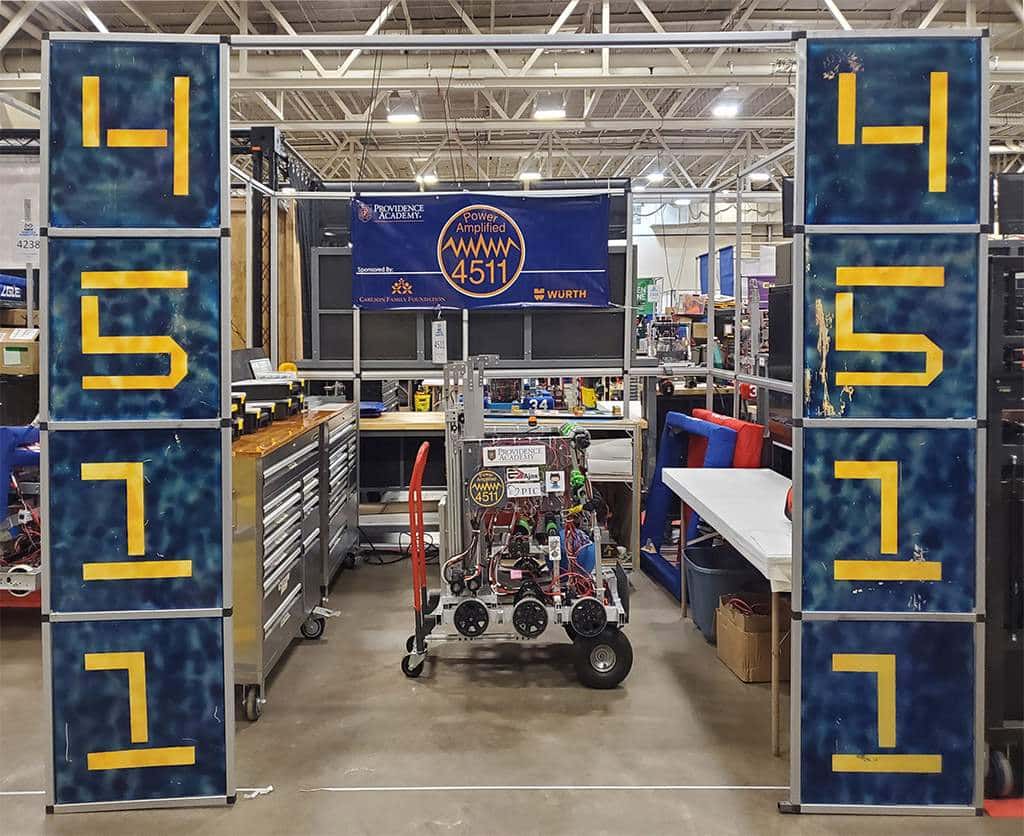
Providence Academy finished the competition with a record of four wins, five losses, and no ties. While the final score did not live up to the team’s high hopes, the event went very well. Most importantly, the team members gained valuable engineering knowledge and experience throughout the process of designing, building, and operating the robot.
View the competition video here: https://youtu.be/7Bj86SpvVD8
Ajax congratulates team leader Michael Plucinski, the physics and engineering instructor at Providence, and the Providence team members who made this year’s competition so worthwhile. Great job everyone!

Providence Academy’s FIRST Robotics Team – #4511 – Power Amplified – successfully concluded their 2021 season! Although challenged by the pandemic, the 2021 team produced a very advanced robot. Here’s the online recap: https://bit.ly/3tZeWkY.
A little background: Michael Plucinski, Providence’s FIRST Robotics Team Instructor, contacted Ajax in early February and explained the team’s need for specialized, laser-cut parts for their 2021 robot. The Providence robot is designed to auto-navigate along complex paths and accurately launch game pieces at a target.
Consistent with the company’s community-service mission, Ajax jumped at the chance and provided expertise, labor, and materials to the team free of charge. Ajax Sales Engineer Jayson Marcott administered the project while the Ajax production team formed the parts on a Salvagnini fiber optic laser and ran them through a deburring machine.
The photo below shows a small portion of the calculations that went into the robot build. Bear in mind that Providence is a K-12 institution. Needless to say, these young people are working and learning at a very high level.

FIRST (For Inspiration and Recognition of Science and Technology) is a non-profit organization that inspires young people to participate in science and technology programs at their schools. Ajax is proud to be associated with this advanced learning and growth opportunity for young people.